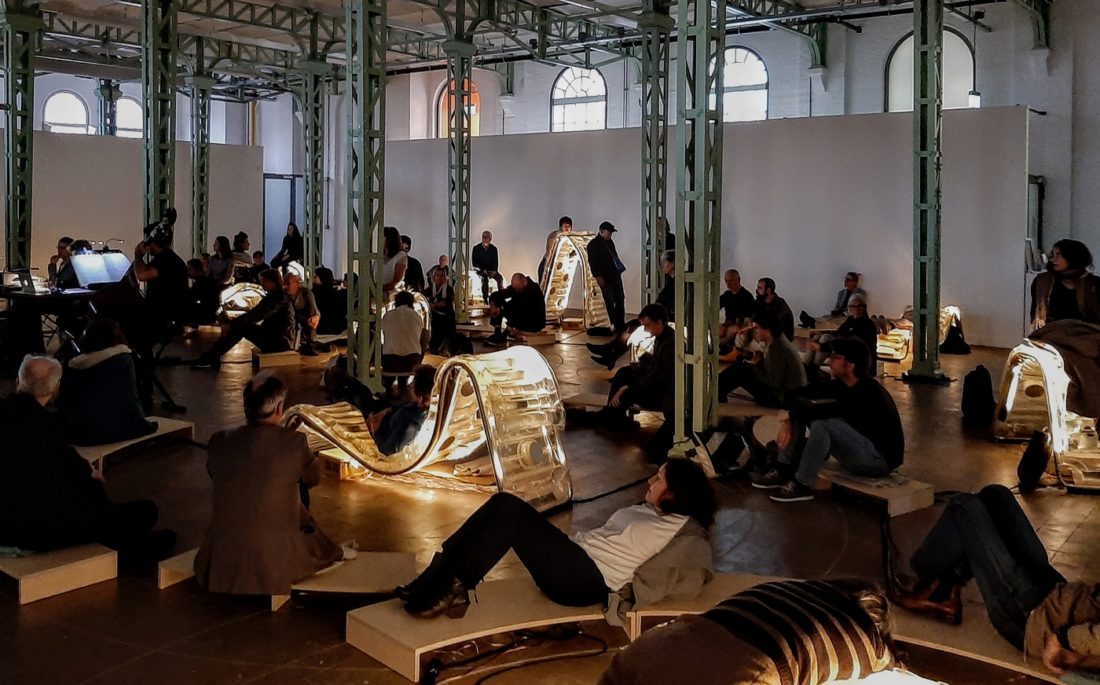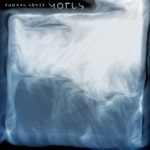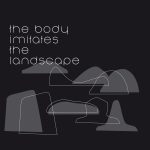DRØNE – THE STILLING 
With a name like that you’d probably expect a collection of extended drones. But it isn’t – far from that (even though drones áre involved)! This is immediately clear from the opening track Mumming, combining city field recordings, found sounds, radio sounds and static humming with electronics intensifying the soundscape. An opening statement telling us that something quite different will follow.
Drøne is a duo, originally, formed by electronic music producer Mark van Hoen and Touch label curator Mike Harding. As Drøne this is their fourth full album (and the third for Anna von Hauswolf’s label Pomperipossa Records). With the help of people like Zachary Paul (violin), Charlie Campagna (bass and cello), Katt Newlon (cello) and extra vocalists Drøne creates a psychedelic sonic trip that is both fascinating and scary.
The album title refers to the phenomenon “whereby the wind speed on the planet seems to be slowing down for no known scientific reason.” But by presenting hectic and disorienting sound sculptures, the album does not exactly reflect this phenomenon of ‘slowing down’ – but so much more the opposite: “We are biologically, psychologically and emotionally able to cope with slow evolutionary change, but struggle with revolutionary, violent distortion or mutation. This leaves us anxious and even desperate for a firmer footing.”
Starting with (more or less) familiar field recording, the album gets more tense with every track, until the penultimate track presents a sonic equivalent of the stargate sequence from Kubrick’s 2001. And after that there is no time for a debriefing: the climax is extended for six more minutes with album closer Hyper Sun – which stops suddenly, leaving you with some indecipherable radio signals.
If you have the feeling that a lot of music in the (ambient) experimental music scene starts to sound the same, this is the one to go.
But a word of warning: there’s plenty of ambience but this is not ambient.
“Scream – it’s all you can do now.”
DRØNE- THE STILLING
THOMAS KÖNER – MOTUS 
A new Thomas Köner release is always a guaranteed sonic adventure. After all, the man is responsible for some of the most immersive, deep soundscapes ever made (his early releases on the Barooni label, Kaamos, Daikan, Nuuk, Novaya Zembla) as well as captivating cinematic sonic sculptures (Unerforschtes Gebiet, Zyklop, La Barca). At the same time, he is an artist exploring different paths, not wanting to repeat himself too often. Later releases, such as Tiento de las Nieves/de la Luz and The Futurist Manifesto took some different turns.
And those are just his solo releases. Apart from that, there are also fascinating collaborations with Asmus Tietchens (as Kontakt der Jünglinge) and Andy Mellwig (as Porter Ricks – “specialized in subaquatic dub techno”).
Porter Ricks is especially worth mentioning here: when I had to place Köner‘s new album Motus (‘movement, motion’, but also ‘advance, progress, passion, sensation, disturbance, tumult, commotion’) somewhere in his musical output, I’d say that is close to that of Porter Ricks, but even more alienated.
Unlike on most of Thomas Köner‘s solo albums, a heavy beat is omnipresent on this album. But it is hidden deep below layers upon layers of filters, blankets and effects – as if it’s the beat from a party quite a few streets away.
“I dream of a dance floor where Motus would be enjoyed. In what kind of world, or rather, what kind of society would allow that? And when? […] Motus is part of this exploration: to find dance, free of clock, and groove, free of rhythm. […] Connecting sky and earth, is the dancer.”
This does not mean Motus presents a collection of dancefloor-fillers: I cannot imagine a crowded dancefloor dancing to these kind of beats. At least not in this world, yet. But Thomas Köner imagines a future time where “the understanding of music expands greatly, when blissful moments are independent of simple melodies, where harmony appears beyond I-V-vi-IV chord progressions, when the techniques of social alienation, which determine the use of all the drugs that accompany recreational music, are reversed into creative tools of exploration.”
Until that time has come, íf it comes in our lifetime, it is best to enjoy Motus in your own private space. Be sure to listen on a decent system, that can handle some heavy subs. You can dance if you want to. And better leave out the recreational drugs, because these sounds are druggy enough in itself.
CLAUDIO F. BARONI – THE BODY IMITATES THE LANDSCAPE
Coincidentally, Claudi F. Baroni‘s previous album was called Motum. His new album, The Body Imitates The Landscape, documents his compositions for the installation ‘for transducer speakers, tape (prerecorded voices), electronics and ensemble’ by Adi Hollander.
It must’ve been a fascinating, if not overwhelming experience: the whispering voices coming from (180) transducer speakers embedded in seventeen waterbeds in different shapes, and from 60 wooden benches – while the soft electronics are accentuated by the (acoustic) Maze Ensemble (“dedicated to performing music that challenges the idea of a fixed form and fixed listening perspectives”).
The Maze Ensemble features a few familiar performers: Anne La Berge (alto flute), Gareth Davis (bass clarinet), Yannis Kyriakides (electronics), Reinier van Houdt (piano, synth).
The texts that are whispered throughout the 11 pieces are inspired by Michitaro Tada‘s Karada (‘the body’). “The sound installation translates the textual experience of reading the book into a sensory one.”

A sound-only representation of an immersive installation like this is, inevitably, only a part of the experience. But even with the sound alone, it is easy to imagine what a beautiful experience this must have been for the visitors that were lucky enough to attend it.
But the the aural document in itself is a sensitive enough experience too. In each track whispered voices describe a part of the body. Aligned with the ensemble and electronics, the voices have a mesmerizing ‘ASMR’-effect. They are whispered, not spoken because the whispering voice “is actually perceived much more as a noise than as a melody. The whispering voice is also called unvoiced speech to distinguish it from normal speech. The composition is written to disclose hidden harmonies which exist in normal speech, and to create a work that is made from the tension between the flow of “unvoiced speech” and the sustained harmonies that are brought to the surface by music instruments.”
The Body Imitates The Landscape is dedicated to the memory of Robert Ashley (1930-2014). The CD version can be obtained from Unsounds.com; Bandcamp only presents the digital download version (which includes a 24-page booklet PDF with extensive liner notes and full lyrics. This booklet was originally made for the live performance of the piece and is not included in the CD-release).






